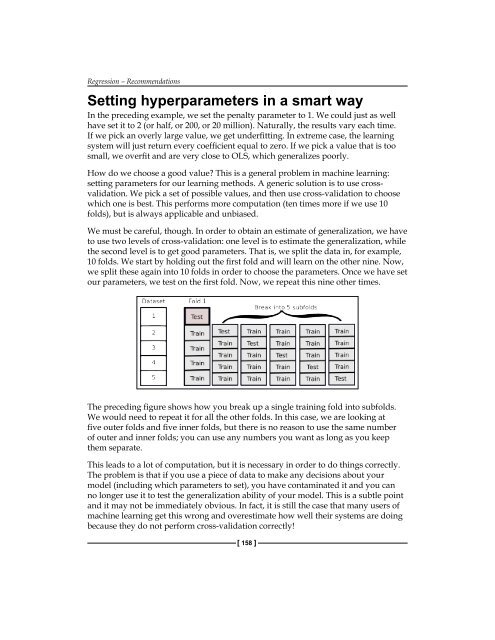1FfUrl0
1FfUrl0
1FfUrl0
Create successful ePaper yourself
Turn your PDF publications into a flip-book with our unique Google optimized e-Paper software.
Regression – Recommendations<br />
Setting hyperparameters in a smart way<br />
In the preceding example, we set the penalty parameter to 1. We could just as well<br />
have set it to 2 (or half, or 200, or 20 million). Naturally, the results vary each time.<br />
If we pick an overly large value, we get underfitting. In extreme case, the learning<br />
system will just return every coefficient equal to zero. If we pick a value that is too<br />
small, we overfit and are very close to OLS, which generalizes poorly.<br />
How do we choose a good value? This is a general problem in machine learning:<br />
setting parameters for our learning methods. A generic solution is to use crossvalidation.<br />
We pick a set of possible values, and then use cross-validation to choose<br />
which one is best. This performs more computation (ten times more if we use 10<br />
folds), but is always applicable and unbiased.<br />
We must be careful, though. In order to obtain an estimate of generalization, we have<br />
to use two levels of cross-validation: one level is to estimate the generalization, while<br />
the second level is to get good parameters. That is, we split the data in, for example,<br />
10 folds. We start by holding out the first fold and will learn on the other nine. Now,<br />
we split these again into 10 folds in order to choose the parameters. Once we have set<br />
our parameters, we test on the first fold. Now, we repeat this nine other times.<br />
The preceding figure shows how you break up a single training fold into subfolds.<br />
We would need to repeat it for all the other folds. In this case, we are looking at<br />
five outer folds and five inner folds, but there is no reason to use the same number<br />
of outer and inner folds; you can use any numbers you want as long as you keep<br />
them separate.<br />
This leads to a lot of computation, but it is necessary in order to do things correctly.<br />
The problem is that if you use a piece of data to make any decisions about your<br />
model (including which parameters to set), you have contaminated it and you can<br />
no longer use it to test the generalization ability of your model. This is a subtle point<br />
and it may not be immediately obvious. In fact, it is still the case that many users of<br />
machine learning get this wrong and overestimate how well their systems are doing<br />
because they do not perform cross-validation correctly!<br />
[ 158 ]


